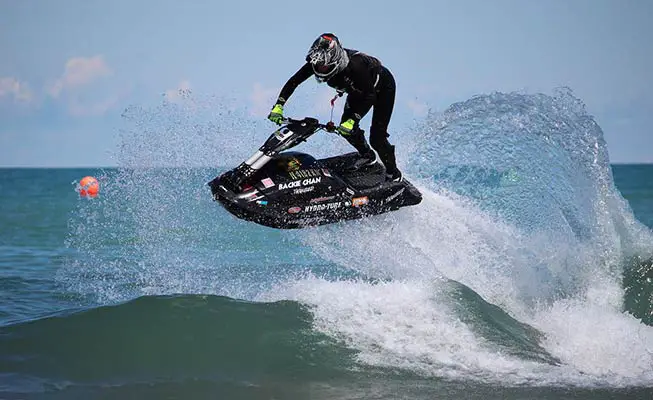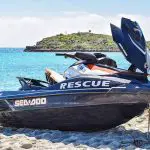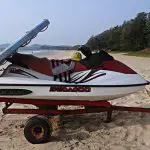I was recently tasked with picking my five favorite places to ride personal watercraft. It was a bit difficult composing such a list from the hundreds of worthy destinations I’ve been fortunate to ski around, but the first pick was easy: The waves just north of Oceanside, California.
On any given morning, swell after swell rolls in towards the shore. Myriad areas are reserved for surfers, who rise early to ride the never-ending waves.
On a jet ski, we choose to ride into the surf, not with it, and we can launch perfectly formed rolling jump faces over and over and over as if we’re riding the world’s largest motocross track.
Interested?
Contents
Getting Started
You don’t have to travel to southern California to jump waves, of course. In north Florida, we keep an eye out for developing weather during hurricane season. If it’s brewing up in the Bahamas, we’re on our way to the beach to hit the swells.
Sometimes even a large lake will build waves on a windy day. And although it’s certainly frowned on in certain circles, a wake boat with a trusted pilot can troll along making big fun for his friends.
All of these things can be dangerous. That is the first and foremost thing to know.
During one hurricane-induced session years ago, riding off Crescent Beach just north of Daytona, the swells were actually building one after another in a way that – to a point – allowed me to jump up from one swell and land smoothly on the backside of the next. Like a motocross track double jump, over and over and over.
And one too many times… I eventually came up short, and buried the nose of the Sea-Doo XP I was riding in the coming swell. One hand blew off the handlebars, my chest flew into the handlebar, and it both knocked the wind out of me and knocked me a little silly. (Yes, I was wearing a helmet. It could’ve been much worse.)
I was done riding for that day, and needed a little help getting my boat across the beach and loaded up. Okay, I needed a lot of help. Actually, I had to get my friends to do it for me. Turns out I’d stress fractured my sternum, cracked my previously broken collarbone, and partially torn my rotator cuff.
So now are you more interested? Or less?
I tell that story of my own rather big mistake to illustrate that wave jumping can hurt you if you overstep the limits. Your own, or your watercraft’s. Modern personal watercraft are so easy to ride, that it’s easy to think you’re invincible and can’t possibly fall off…
But you can, and likely will. So let’s discuss a few things first timers should know and consider. And maybe even talk about the best boats available for wave jumping.
Start Slow and Small
I can’t stress enough that launching an 800-pound muscleboat with hefty horsepower off of waves can result in heavy penalties. Your PWC might seem somewhat docile and user-friendly even at speed on a lake, but the ocean is a volatile environment.
Waves roll in and break in a rhythm, but that beat is a bit syncopated. It changes, it moves, and it can create grooves that can send one veering off course rather rapidly.
So start small, and start slow.
Most of us veterans of the sport began our wave jumping on stand-up skis, and were thus restricted by our own skill in how hard or fast we could launch off a wave. Balance was key, and our skis were very lightweight and somewhat less powerful than today’s most popular machines. (I’m going to refrain from going off on a tangent about power to weight ratios, suffice to say they weren’t all that slow despite modest horsepower ratings, because they also didn’t weigh all that much.)
Your modern runabout is so stable it provides a false sense of security. Don’t go too big too early, or you’re likely to go home battered and bruised – or maybe even to the hospital.
Waves of about three feet tall are what you need to begin to get a feel for how to launch off a wave, for how your boat responds to both weight and throttle input, and how to dial in a landing that will be smooth.
Putting the Cart Before the Horse
I’m actually going to begin with the end, the aforementioned landing.
What you want to achieve is a tail-first, or jet pump-first landing.
If you land flat, hull perpendicular to the water, you’re going to be putting a tremendous pounding on both your boat and yourself. I’ve seen big flat landings break motor mounts right out of a PWC – and seen it break worse things, like bones.
A flat drop on an 800-pound boat from five feet in the air is going to create more impact than if you climbed up on the roof of your house and jumped off. It’ll be rough.
And although it’s obvious, I’ll refer to my own story above about the perils of dropping the bow and reentering the water nose-first. If you only fly over the handlebars, you’ll be lucky.
The aim is to land at about a 30-40 degree angle with the bow in the air and the stern touching down first, allowing the weight of both the boat and yourself to set down the front after the rear has already touched.
So how do you do that?
Hitting the Lip
Approach an oncoming wave at little more than idle speed. When you reach the transition – the area where the water begins to rise – throttle into the wave while keeping your weight to the rear of the craft.
If you have a particularly powerful PWC, you might even consider utilizing the “learner” mode if your ski offers one while first getting a feel for this. Too much throttle will get a neophyte in a world of hurt, so don’t overdo it at first.
Keep both your knees and elbows bent as you take off and while in the air. This will help you absorb the impact of landing – and even when you get it right, there will be an impact.
Once you’re in the air, it’s best practice to let off the throttle, as it’s pretty harsh on your impeller and drive assembly to go from spinning at high revs with no restriction to suddenly having to move water again.
Also, landing with the throttle still open could lead to a sudden burst of acceleration that won’t allow you to settle with your boat as you land. You don’t want it shooting off in front of you.
With more experience, you’ll find that reapplying power just after the pump hits the water can actually smooth the landing – but again, that’s a relatively advanced technique that you shouldn’t explore until you’re able to consistently land in the proper position.
Safety First, and maybe even All Gear All the Time
If I’m planning to go big, I’ll run a helmet, knee braces, and jet boots that offer considerable ankle support.
But like anyone else, I might engage in a little impromptu jumping from time to time while dressed more for the beach than for the ride. But here are two obvious essentials: A quality flotation device, and a lanyard that is secure and in working order.
Beyond that, it’s mostly common sense. Start on small waves before moving on larger jumps. Make sure you’re in an area that is well clear of swimmers, surfers, or other boaters. Always make sure you’re visible to other riders, and that you can see them as well. It’s a sickening feeling to launch over a wave only to see your buddy in your landing pattern.
Finally, you’re going to want to be reasonably athletic. You will, in fact, be quite sore after an hour or so of jumping waves even if you are in great physical shape. If you’ve got a bad knee (*raising my hand) or a bum shoulder (*painfully raising my other hand) be mindful of your limitations. Jumping a jet ski is a damned poor way to rehabilitate an injury, to say the least. And it’s a hell of a way to get one.
Recommended reading: How to Safely Ride a Jet Ski
Best Boats
Although I’m of the mind a stand-up ski is the best way to learn anything about controlling a personal watercraft, especially jumping one, I’m painfully aware that ship has largely sailed.
Though it is fantastic that both Kawasaki and Yamaha continue to offer a more modern version of the machines that started the PWC sport, most have never and will never ride a stand-up. Alas.
Enough lamentation. Point is, I’m sticking to runabouts for this article. But you might see where I’m going with this.
Too Big, Too Heavy, Too Fast
Look, you can go jump waves on your RXP or Turbo 6000 whatever, but you’d have a lot more fun doing it on something much lighter and more maneuverable.
“Oh, I cut a pretty mean rug on my Ultra 310!,” you say… and that may be, but I’m not talking about that kind of maneuverability.
Part and parcel to jumping anything – well, almost anything, I guess my experience is somewhat limited to skateboards, bicycles, motorcycles, PWC, and boats… maybe a pogo stick once… – is weight transfer by the rider. How you weight and un-weight while hitting the “ramp” and then in the air.
You want to push into the face of the jump, or wave, and then unload your weight under flight. I sometimes explain it as how a shortstop in baseball or a point guard in basketball is always on the balls of their feet, never flat-footed or back on their heels. Athletic pursuits require us to sort of dance around a bit.
To get back on point, when we used to ride 400-pound two-stroke runabouts with 80 or 100 horsepower, we could really affect our flight pattern by how we weighted the ski. Moving around, back and forth, from front to back, to achieve the right amount of angle for re-entering the water.
If a Sea-Doo XP or the like was to go off a wave tipping to the left, for example, we could right the wrong by shifting the weight to our opposite foot.
This is much less possible with a heavier and more powerful modern watercraft.
At 6-foot-1, 185 pounds, I’m a reasonably full-sized man. But I still only have about 25 percent of the mass of a full-sized three-seat PWC. When I was riding 400-pound boats the weight ratio was much closer, and thus body positioning was much more influential to my flight path.
If you were choosing a machine specifically for jumping waves, or spins or tricks for that matter, I’d recommend a much lighter craft. Something like Sea-Doo’s Spark, Yamaha’s EX, or a boat I haven’t ridden yet but am dying to, the new Yamaha JetBlaster.
Days of Yore
The most fun I’ve ever had jumping waves was on Yamaha’s original WaveBlaster.
It came off Yamaha’s design table intended as a buoy boat, designed for leaning in through the corners motorcycle style. It also had near perfect power and weight distribution for jumping waves.
The WaveBlaster was less than two-thirds the size of most modern personal watercraft, measuring a mere 95.7 inches long and 34.6 inches wide. And though initially offered with just 64 horsepower from Yamaha’s two-stroke twin 700cc powerplant, it weighed only 320 pounds!
Yamaha would later up the ante with a dual-carb version of the same motor with another 10 ponies on tap, but even the early versions offered quick acceleration – albeit with a very modest top speed – and were as lively as it was light.
The nimble craft designed for racing quickly took the lead for freestyle type ocean riding.
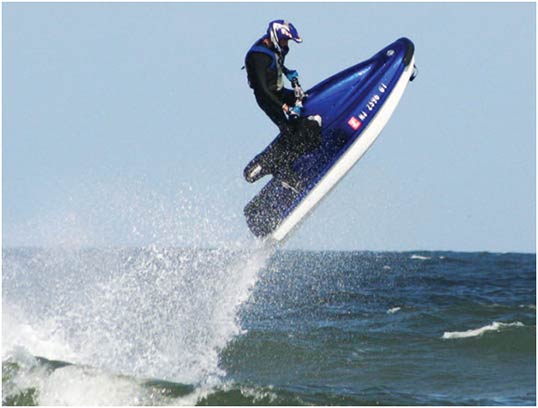
Alas, the suitability of the WaveBlaster for freestyle also meant quite a few of them were used and abused and worn flat out.
As a narrowly-focused craft, they never sold in huge numbers. It’d be a lot easier to find a WaveRunner 3 from the era still running and still for sale. But I certainly don’t recommend that as a plan for jumping waves – or any other reason, for that matter.
Enter Yamaha’s newest release, the JetBlaster.
The ‘Blaster Reborn?
Albeit a good bit larger than the WaveBlaster, at just 549 pounds and 123.6 inches long with 110 horsepower on tap from Yamaha’s three-cylinder four-stroke 1049cc high output engine, the specs of Yamaha’s latest release have me half salivating to ride one, and half scared for my wallet if I did.
I skipped over the power-to-weight ratio sidebar earlier, but I can’t help but note that the JetBlaster has 1 horsepower for every 4.99 pounds of weight. The original, the WaveBlaster, in its two carb-version, had 1 horsepower for every 4.32 pounds of weight.
Close enough for me. I want one. Bonus points to Yamaha for listing the new ‘Blaster as a “freestyle” selection on its website.
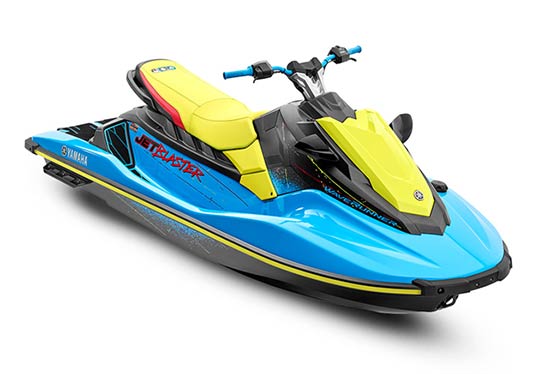
The new Yamaha appears to be based on the outgoing EXR model, with a similar hull design that features a whopping 60-pound weight reduction through the use of the company’s proprietary NanoXcell hull material in both the hull and the top deck.
Nothing is more important than that weight diet, but the new model also features a wider handlebar at 30 inches on a cast aluminum neck that reminds one of PWC prepped for racing, an electric trim that has a wider range than most models, and angled footwell chocks at the tail of the footwells – somewhat similar to Sea-Doo’s Spark Trixx model.
Hell, I think everyone should buy one. And then invite me out to test ride it!
Alternative Selections
I wrote about the various Spark models available here, so click away for a more in-depth overview of this also a very attractive choice for hitting the waves.
Here’s the tale of the tape: The Spark Trixx model, which comes with Sea-Doo’s 90-horsepower ACE 900cc engine, weighs in at 428 pounds for the two-seat model and 439 pounds for the three-seat model.
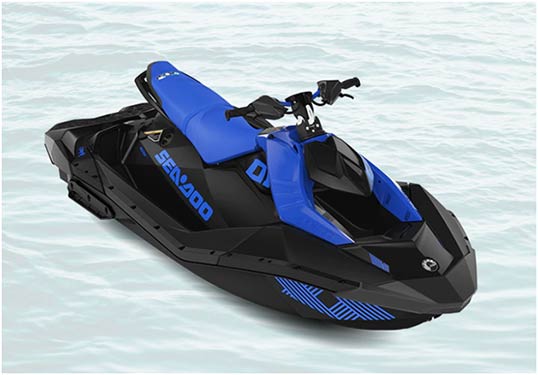
Using the three-seater for an apples to apples comparison, that works out to 1 horsepower for every 4.87 pounds – very close to the Yamaha JetBlaster’s 1/4.99 ratio!
The new JetBlaster retails at $9999. The Spark Trixx sells for $7899.
The third “best boat” for jumping waves on sales floors is back at the Yamaha dealer, where they’ll sell you a base-model WaveRunner EX for just $7199. The EX uses the same 100-horsepower engine as the new ‘Blaster, but weighs in much heavier at 580 pounds with its more traditional hull construction.
You can read more about the Yamaha EX lineup here.
Power to weight ratio works out to 1 pony for every 5.8 pounds, so the EX isn’t going to leap out of the water with quite the authority of the ‘Blaster or the Spark… but I’d still take one for a day of wave jumping anytime. And especially over a much heavier and more powerful PWC.
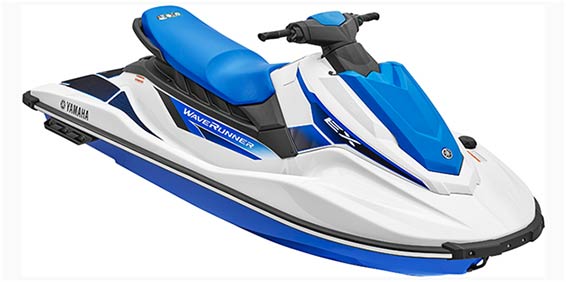
Horses for Courses
You pay your money, and you make your choices. Any of these would be a top watercraft for jumping around in the sun. Selecting from what I have ridden, I’d have to give the nod to the Sea-Doo as the best combination of a reasonably versatile machine that would still make an excellent choice for solo freestyle riding.
But I haven’t ridden the new Blaster yet, dammit. And I suspect that I want one, dammit. If I’ve any readers who’ve managed to procure one in the North Florida area, hit me up!
Finally, you can jump waves on any personal watercraft and have fun. It’s more fun on a lighter machine, however, with less impact. One more time for emphasis: Start slowly, on smaller waves, and work your way up as your skill and confidence rises. Leave your ego on the shore and stay within your own abilities.
